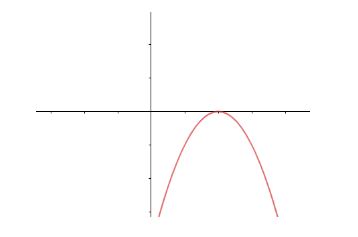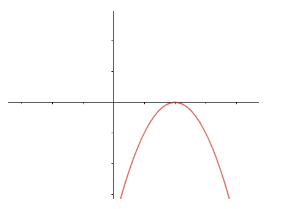
The number of zeroes of the polynomial from the graph is

(a) 0
(b) 1
(c) 2
(d) 3

Answer
584.7k+ views
Hint: Start drawing all the details about the equation of the curve that you can gather from the graph given. The given is a parabola, so, the equation of the curve is a quadratic equation, so can have a maximum of two roots. Also, it is touching the x-axis, i.e., meeting the x-axis at only one point, so it has repeated roots. So, use all these details to reach the answer.
Complete step-by-step answer:
Let us start the solution to the above question by drawing the graph given in the question.

The curve given in the question is a parabola. For example: A general parabola with vertex at (0,0) can be represented by the equation $ {{x}^{2}}=4ay $ , which is a polynomial in which the maximum power of x is 2, so it is a quadratic equation. So, it is a sure thing that the equation of the curve is a quadratic equation. As it is a quadratic equation, the degree of the equation is 2, so it can have a maximum of two roots.
Also, the graph is touching the x-axis at a single point and the number of points where a curve cuts the x-axis is the number of roots of the equation of the curve. So, the given curve has one repeated root, i.e., only one root.
Hence, the answer to the above question is option (b).
Note: The other things that we can get after looking at the curve in the graph is: the coefficient of $ {{x}^{2}} $ in the equation of the curve is negative as the parabola is opening downward. Also, the root of the equation is positive, as the graph meets the x-axis in the right of the origin. The range of the equation of the curve is $ (-\infty ,0] $ .
Complete step-by-step answer:
Let us start the solution to the above question by drawing the graph given in the question.

The curve given in the question is a parabola. For example: A general parabola with vertex at (0,0) can be represented by the equation $ {{x}^{2}}=4ay $ , which is a polynomial in which the maximum power of x is 2, so it is a quadratic equation. So, it is a sure thing that the equation of the curve is a quadratic equation. As it is a quadratic equation, the degree of the equation is 2, so it can have a maximum of two roots.
Also, the graph is touching the x-axis at a single point and the number of points where a curve cuts the x-axis is the number of roots of the equation of the curve. So, the given curve has one repeated root, i.e., only one root.
Hence, the answer to the above question is option (b).
Note: The other things that we can get after looking at the curve in the graph is: the coefficient of $ {{x}^{2}} $ in the equation of the curve is negative as the parabola is opening downward. Also, the root of the equation is positive, as the graph meets the x-axis in the right of the origin. The range of the equation of the curve is $ (-\infty ,0] $ .
Recently Updated Pages
Master Class 8 Social Science: Engaging Questions & Answers for Success

Master Class 8 Maths: Engaging Questions & Answers for Success

Master Class 8 Science: Engaging Questions & Answers for Success

Class 8 Question and Answer - Your Ultimate Solutions Guide

Master Class 8 English: Engaging Questions & Answers for Success

Why are manures considered better than fertilizers class 11 biology CBSE

Trending doubts
What is BLO What is the full form of BLO class 8 social science CBSE

Citizens of India can vote at the age of A 18 years class 8 social science CBSE

Full form of STD, ISD and PCO

Right to vote is a AFundamental Right BFundamental class 8 social science CBSE

What is the difference between rai and mustard see class 8 biology CBSE

Summary of the poem Where the Mind is Without Fear class 8 english CBSE




